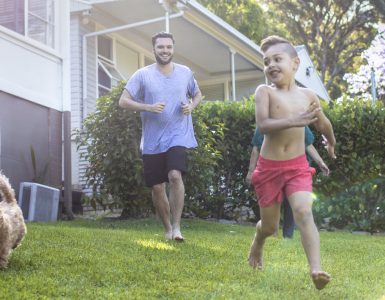Exercise is one of the best things you can do to contribute to your health and well-being. No matter your age or stage in life, there are many healthy reasons to exercise and many exercises you can participate in. Keep reading to learn why fitness is for life and tips to help you at each stage!
The primary reason that exercise should be a lifetime activity is due to its benefits. Exercise strengthens the heart, lungs, bones and muscles. It can help the body more effectively use glucose and may help clear veins and arteries of cholesterol build-up. Additionally, exercise may help you control your weight, feel happier, and improve your outlook, balance and coordination, brain function, energy levels and quality of sleep. Consequently, exercise may help reduce the risk of serious health issues such as diabetes, cardiovascular disease and cancer, as well as the chance of cancer recurring.
Exercise tips for children (3-5)
- Children should be active as much as possible throughout the day to help them grow strong and encourage healthy habits.
- Find multiple activities your child enjoys—the greater the variation, the better for the growth and development! Click here for activity ideas to keep your child active.
- Making exercise fun is important to engage this age group in physical activity.
- Be a role model and participate in the activities with your children instead of being spectator.
Exercise tips for adolescents (6-17)
- Adolescents also need a variety of activities. This includes at least 60 minutes of activity daily, which should include resistance and bone-strengthening activities on at least 3 days per week.
- Organized sports through the school or community teams are a convenient way to help this age group stay active as well as learn the importance of teamwork and sportsmanship. Click here for tips on how to keep your student athlete safe!
- Technology often inhibits this age group from being active. Set a good example—make being active part of your daily life to encourage them to do the same.
Exercise tips for adults (18-64)
- Aim to get at least 150 to 300 minutes (5 hours—or an hour on most days a week) of moderate-intensity exercise each week, like brisk walking, or 75 to 150 minutes of vigorous exercise each week such as running or hiking uphill.
- Build up beyond 300 minutes—gradually. Take your time to build your strength and endurance with exercise. The more physical activity you do, the greater the benefits experienced, but doing too much too soon can be dangerous!
- Include strengthening activities to work your all of your muscles. Click here for tips.
- Traveling or have a particularly tight schedule this week? For those times when you can’t fit in the 150 to 300 minutes of exercise, think about how you can incorporate physical movement into everyday activities, like taking the stairs instead of the escalator, for instance. Consistent movement is key to good health!
Exercise tips for older adults (65+)
- In addition to the tips above, if you fall into this age group it is important to incorporate balance exercises to improve your coordination. This is important to include as it may help reduce falling. Tai chi, yoga and Pilates are great exercises to try.
- When selecting exercises, choose those that will help you become more efficient in your everyday activities.
- Consider your activities carefully based on your fitness level and if you have any chronic conditions or other health issues that could affect your ability to exercise.
Start enjoying the benefits of exercise today—plan your workout routine with the tips that apply to you and your family! Remember, talk to your doctor before beginning to exercise or prior to trying any new exercises. It is important to choose activities that are safe for you and your situation.



